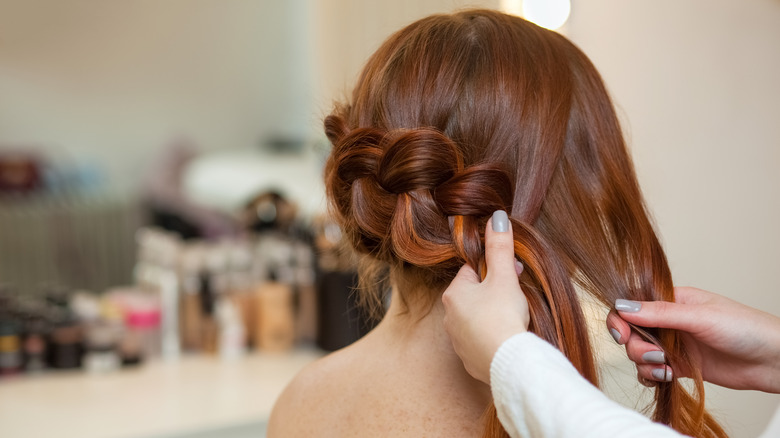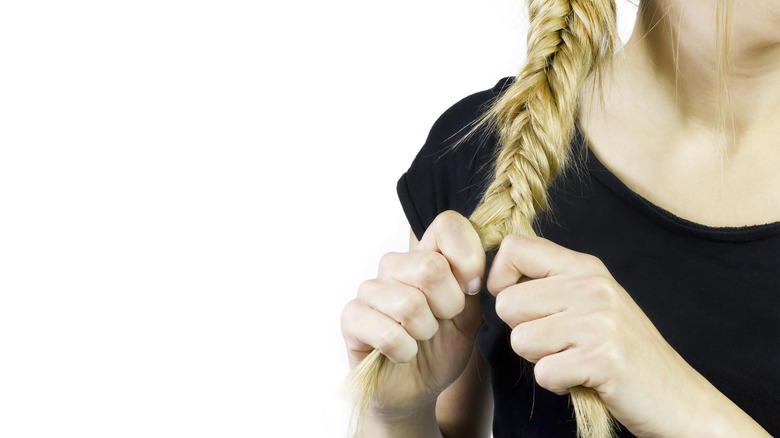Here's How To Do Your Own Fishtail Braid
Braids have been a popular hairstyle for thousands of years after originating in Namibia, according to Byrdie. Over all that time, the creative options for braiding have expanded into a vast universe that includes many different varieties. For instance, the traditional three-strand version can be modified into a French or Dutch braid. To branch out further from the more typical styles, a fishtail braid is an ideal hairstyle for long hair.
As Everyday Hair Inspiration points out, a fishtail braid is a great choice because it looks more complicated than it actually is, alongside incorporating bohemian elements. In fact, Fairfield University reports that fishtail braids date back to 430 BCE in Athens, Greece when sculptures of maidens called Caryatids were carved. These statues had different iterations of fishtail braids and adorned the Erechtheion temple on the Acropolis.
Given the complex appearance of the finished braid, this style has been popular at New York Fashion Week (via The Zoe Report), while Vogue identified fishtail braids as a top hairstyle trend for 2022. While the herringbone pattern may look daunting, this striking style is actually much easier to recreate than it appears on the surface. Here's how to do it.
Two strands trade off to form a fishtail braid
Even though they look intricate, fishtail braids are created using just two strands of the hair instead of the usual three that make up a traditional braid. Celebrity hairstylist Justine Marjan suggested starting out with your unwashed hair (which is generally easier to handle) swept over into a side ponytail, so you can follow the braiding process in the mirror. After the hair is divided in half, "Take a small piece from the outside of one section and add it to the inside of your other section," she told Byrdie.
Next, Marjan instructed, "Take a small piece from the outside of the other section; add it to the inside of your other section." Everyday Hair Inspiration offers a step-by-step picture tutorial that details how each segment of the braid looks as it travels from outside to inside. Essentially, each time a new piece is added, the other hand helps to keep the emerging braid secured in place.
YouTuber Kayley Melissa compares the braiding process to playing catch with your hair. Instead of tossing a ball, you trade-off with each section catching a strand from the other. After the braid is secured, you can choose to wear it sleek and tight or loosen up the strands to make it messier. When loosening the braid, Marjan likes to work upwards from the end for a relaxed, boho look (via Byrdie).
There are plenty of intricate fishtail variations
Once you've mastered the basics of a fishtail braid, you can explore some of the variations for an added twist on the style. For starters, Hair.com recommends trying an inverse fishtail. Similar to the standard fishtail, this version is created by passing the segments of hair underneath as they journey from one section of hair to the other. As Good Housekeeping notes, this technique of moving the hair underneath rather than over the top is also what is used in Dutch braids.
For another combo of braid types, Luxy Hair offers a tutorial on a French fishtail. It describes the braid as alternating between the two sections of a "small fishtail" at the center while incorporating two outside strands that make up the "big fishtail." If the final product looks familiar, you may have seen it in "The Hunger Games," since a French fishtail is Katniss' go-to hairstyle.
To up the complexity, Hair and Nails Inspiration showcased what they call a "mermaid tail" (via YouTube). This doubled-up fishtail involves looping each strand of hair around its original section before passing it over to the other section to create a thick, beautiful braid. For shorter hair, YouTuber Milabu demonstrates a fishtail updo made up of three smaller fishtail braids. To finish, the three fishtails are pinned together to create a seamless look.


